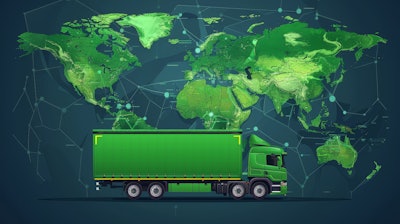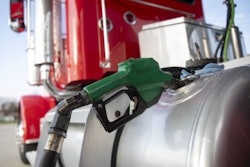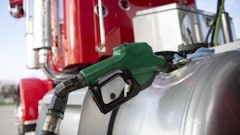
The yard is the crossroads of every distribution center and manufacturing plant. Yard trucks move trailers in and out of docks, keep production lines fed, and connect transportation with warehousing. Yet most of those trucks still run on diesel, burning thousands of gallons of fuel each year and releasing tons of emissions into the atmosphere, according to the U.S. EPA’s SmartWay Program.
Unlike over-the-road fleets, yards have short routes, predictable duty cycles, and centralized fueling or charging. That combination makes change controllable and measurable. When processes are standardized, even minor improvements scale quickly across an entire network. Right-sizing fleets, upgrading to modern or electric terminal tractors, and enforcing preventive maintenance all cut diesel use and downtime. Research from CALSTART shows that gate discipline and improved trailer slotting can further reduce idling, which typically burns about one gallon of diesel per hour. The U.S. Department of Energy calculates that each gallon avoided prevents roughly 22 pounds of CO₂ from entering the atmosphere. Those are results finance and sustainability teams can both trust.
Beyond the spreadsheet: What sustainability really means
Too often, sustainability is reduced to a reporting exercise: fill in the Scope 1 box, convert gallons to CO₂, attach an appendix. The forms matter because they create accountability. But the real work happens on the ground. True sustainability is not only about hitting emissions targets or satisfying ESG checklists. It is about people.
Diesel yards are tough places to work. Noise, exhaust, and frequent breakdowns wear down drivers’ health, morale, and productivity. The American Lung Association has documented the health risks of diesel exposure, including respiratory disease and cardiovascular stress. Electric yard trucks change that equation. Quieter operations reduce stress and fatigue. Cleaner air improves working conditions, with studies from Harvard’s T.H. Chan School of Public Health linking reduced particulate matter to better long-term health outcomes. More reliable equipment means smoother, safer shifts with fewer disruptions, as highlighted by the North American Council for Freight Efficiency.
For companies competing in a tight labor market, these improvements go beyond compliance. The Bureau of Labor Statistics notes that truck driver turnover remains one of the highest in any industry. Healthier, safer yards help attract and retain skilled drivers, reduce injuries, and lower turnover. They also foster a culture where employees feel valued and where sustainability directly improves quality of life.
Why yard operations must evolve
A well-run yard keeps everything moving: trailers reach dock doors on time, warehouses stay on schedule, and carriers avoid costly detention. But when yards stumble, the entire supply chain feels it. Labor hours are wasted, shipments miss deadlines, and costs rise.
Fuel alone is a major driver. The EPA SmartWay Program estimates that a single diesel yard truck consumes about 1,800 gallons of fuel per year. Across a national network, the spending and emissions quickly add up. For decades, yards were treated as an afterthought. In reality, McKinsey & Company identified yard operations as one of the fastest levers to cut costs, reduce emissions, and build resilience, precisely because every load passes through a yard.
The case for electrifying yard trucks
Switching from diesel to electric yard trucks is one of the clearest wins in logistics:
● Fuel savings: According to EPA data, each EV yard truck saves approximately 1,800 gallons of diesel fuel annually. Multiply across a network and the financial impact is immediate.
● Carbon cuts: According to the EPA’s greenhouse gas equivalencies calculator, replacing 50 diesel yard trucks across the network can eliminate more than 90,000 gallons of fuel use and cut over 1,000 metric tons of CO₂ per year. That is equivalent to removing 200-300 passenger cars from the road per year.
● Lower maintenance: The North American Council for Freight Efficiency reports that EVs cost 40-80% less to maintain, thanks to fewer moving parts. No oil changes, fewer breakdowns, less downtime.
● Higher uptime: Orange EV states that yard truck EVs have 96-99% uptime and are easier to repair
● Better workplaces: Drivers immediately notice the difference. CALSTART studies highlight how EVs run quieter, improve air quality, and enhance safety, all of which boost morale and retention.
Where do you start?
It's important to highlight that at the same time that yard truck EVs are an operational no-brainer, there are still challenges to be reviewed from higher upfront costs, charging infrastructure, and multi-site coordination. Transitioning to electric is not as simple as ordering new trucks. Success requires planning and expertise. That is why many enterprise shippers are turning to specialized yard logistics partners who provide:
● Immediate access to EV fleets without heavy upfront investment
● Regulatory expertise to capture grants, incentives, and ensure compliance
● Scalable deployment across multiple facilities for consistent performance
● Smarter fleet management with monitoring, analytics, and predictive maintenance
Outsourcing does not mean giving up control. It means accelerating the transition while reducing risk and improving the overall efficiency of yard operations. It's a true win-win-win situation.
The call to action
The fastest path to decarbonizing logistics is not on the highway. It is in the yard. Companies that ignore this opportunity are leaving money, efficiency, and resilience on the table. For enterprise shippers serious about both sustainability and competitiveness, the mandate is clear: standardize yard operations, electrify fleets, and scale success across the network.
















